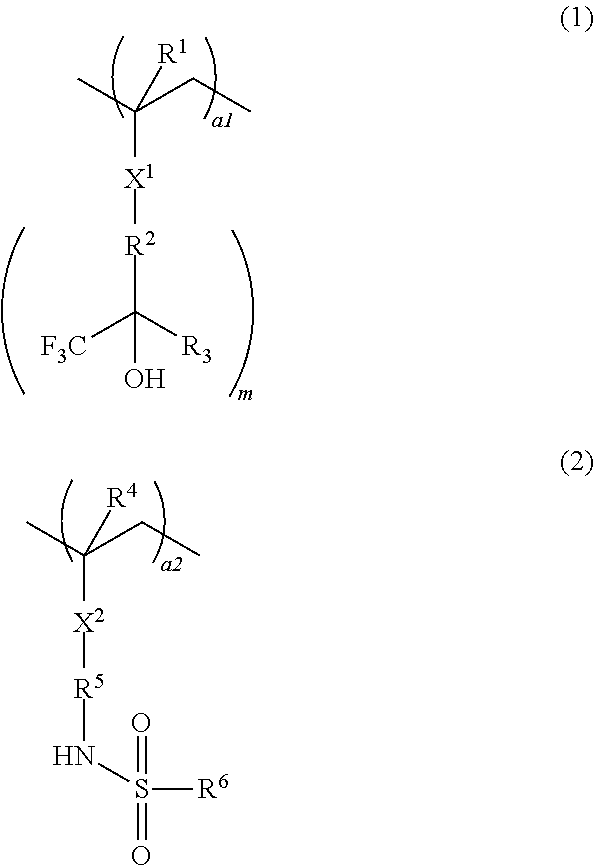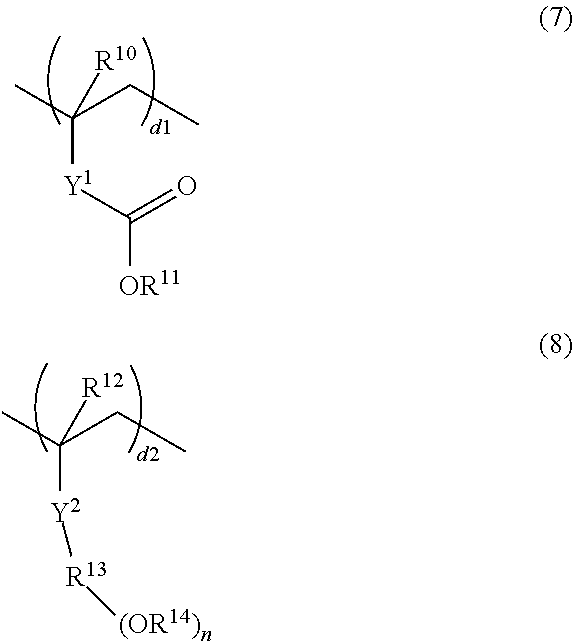Patterning process
- Summary
- Abstract
- Description
- Claims
- Application Information
AI Technical Summary
Benefits of technology
Problems solved by technology
Method used
Image
Examples
example
[0161]Preparation Examples, Examples and Comparative Examples are given below for further illustrating the invention, but they should not be construed as limiting the invention thereto. All parts (pbw) are by weight.
[1] Preparation of Resist Composition
preparation examples 1 to 5
[0162]A resist composition was prepared by dissolving a base resin, fluorine-containing polymer, acid generator, quencher and surfactant in a solvent in accordance with the recipe shown in Table 1, and filtering through a polyethylene filter having a pore size of 0.2 μm. The components used herein are identified below.
TABLE 1Fluorine-containingAcidResistPolymerpolymergeneratorQuencherSurfactantSolventcomposition(pbw)(pbw)(pbw)(pbw)(pbw)(pbw)R-1BaseFluorine-containingPAG1Quencher 1FC-4430PGMEAresin 1polymer 1(6.0)(6.0)(0.001)(2,000)(100)(3.0)GBL(250)R-2BaseFluorine-containingPAG1Quencher 1FC-4430PGMEAresin 1polymer 2(6.0)(6.0)(0.001)(2,000)(100)(3.0)GBL(250)R-3BaseFluorine-containingPAG1Quencher 1FC-4430PGMEAresin 1polymer 3(6.0)(6.0)(0.001)(2,000)(100)(3.0)GBL(250)R-4BaseFluorine-containingPAG1Quencher 1FC-4430PGMEAresin 1polymer 4(6.0)(6.0)(0.001)(2,000)(100)(3.0)GBL(250)R-5BaseFluorine-containingPAG2Quencher 2FC-4430PGMEAresin 2polymer 1(6.0)(6.0)(0.001)(2,000)(100)(3.0)GBL(250)* ...
PUM
| Property | Measurement | Unit |
|---|---|---|
| Temperature | aaaaa | aaaaa |
| Temperature | aaaaa | aaaaa |
| Percent by mass | aaaaa | aaaaa |
Abstract
Description
Claims
Application Information
 Login to View More
Login to View More - R&D
- Intellectual Property
- Life Sciences
- Materials
- Tech Scout
- Unparalleled Data Quality
- Higher Quality Content
- 60% Fewer Hallucinations
Browse by: Latest US Patents, China's latest patents, Technical Efficacy Thesaurus, Application Domain, Technology Topic, Popular Technical Reports.
© 2025 PatSnap. All rights reserved.Legal|Privacy policy|Modern Slavery Act Transparency Statement|Sitemap|About US| Contact US: help@patsnap.com



